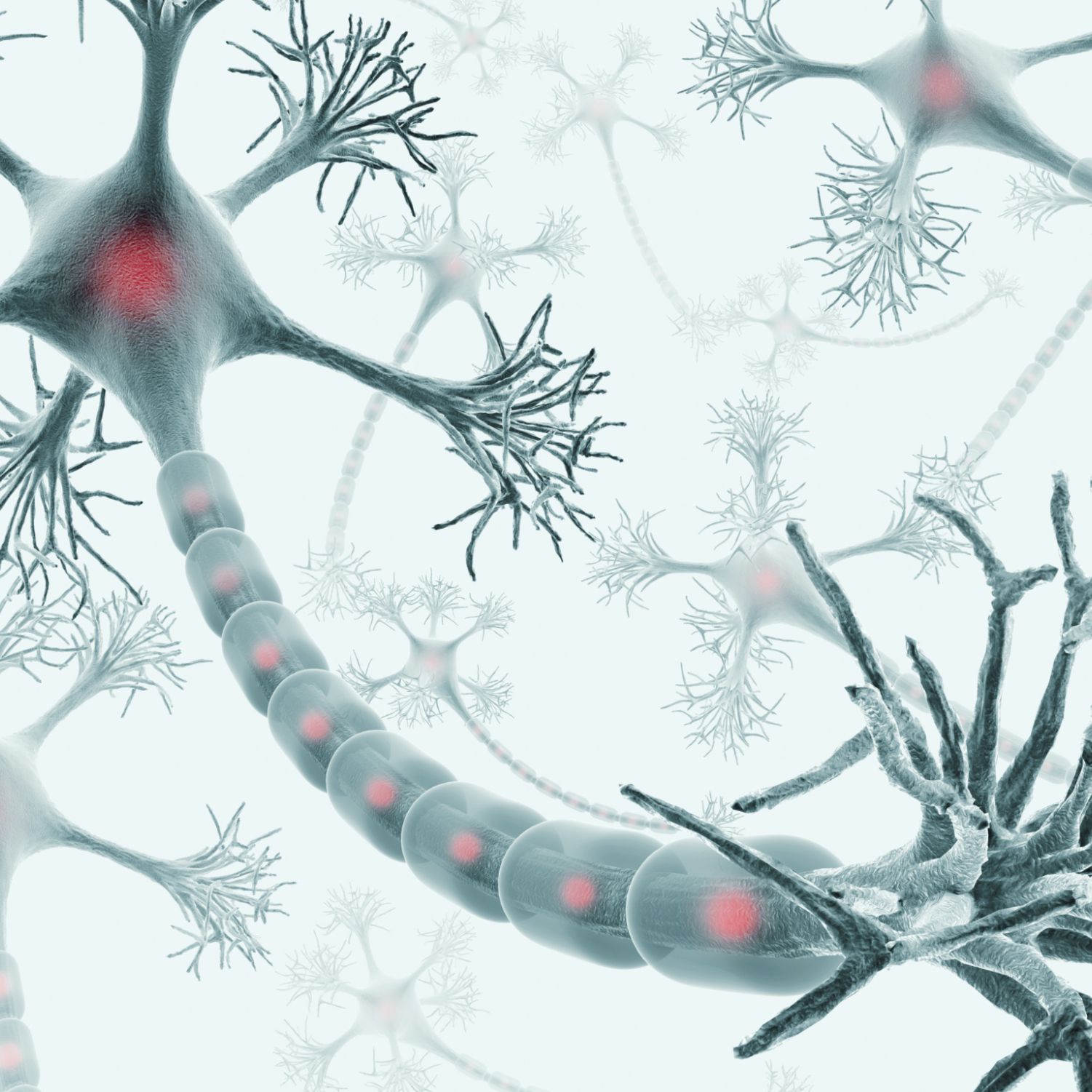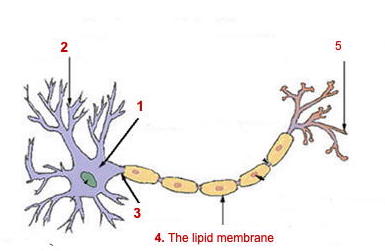Neurotransmission: checking understanding
 The following worksheet checks your understanding of neurotransmission on behaviour. Try to answer the questions first before checking the answers that are provided in the "hidden boxes."
The following worksheet checks your understanding of neurotransmission on behaviour. Try to answer the questions first before checking the answers that are provided in the "hidden boxes."
Sample responses
1. Label the following neuron

This is a simple neuron, so no tricks here. The answers are 1) Soma or cell body; 2) dendrites; 3) the axon; 4) the myelinated sheath; 5) terminal buttons or terminal bulbs
2. Describe the process of neurotransmission.
Dendrites receive a neuro-chemical stimulus by having a neurotransmitter attach to a receptor site; the electrical charge that passes through the neuron will then activate the terminal bulbs to release neurotransmitters so that the process continues.
3. What is the difference between the excitatory function and the inhibitory function of a neurotransmitter?
Some neurotransmitters are commonly described as "excitatory" or "inhibitory". The only direct effect of a neurotransmitter is to activate one or more types of receptors. The effect on the postsynaptic cell depends entirely on the properties of those receptors. It happens that for some neurotransmitters (for example, glutamate), the most important receptors all have excitatory effects: that is, they increase the probability that the target cell will fire an action potential. For other neurotransmitters (such as GABA), the most important receptors all have inhibitory effects. There are neurotransmitters, such as acetylcholine, for which both excitatory and inhibitory receptors exist; and there are some types of receptors that activate complex metabolic pathways in the post-synaptic cell to produce effects that cannot appropriately be called either excitatory or inhibitory. Thus, it is an oversimplification to call a neurotransmitter excitatory or inhibitory.
4. What happens to the neurotransmitters once they are in the synapse?
Neurotransmitters must be broken down once they reach the post-synaptic cell to prevent further excitatory or inhibitory signal transduction. There are two ways that this may happen. First, an enzyme may break down the neurotransmitter; for example, acetylcholine is broken down by the enzyme acetylcholinesterase. The second method of elimination of neurotransmitters from the synapse is "re-uptake." Re-uptake is the reabsorption of a neurotransmitter by the terminal buttons of the pre-synaptic neuron. Reuptake allows for the recycling of neurotransmitters; it regulates the level of neurotransmitter present in the synapse and controls how long a signal resulting from neurotransmitter release lasts.
5. What is one criticism of the argument that a behaviour can be attributed to a neurotransmitter?
There are several potential answers to this question. The argument that neurotransmission is the cause of behaviour is reductionist. Although a reductionist argument may be good in the study of memory since such arguments could potentially lead to positive strategies for helping people with memory impairment, explaining a complex behaviour such as falling in love as a "neurochemical cocktail" may be considered an oversimplification of human behaviour - ignoring cognitive and sociocultural factors in the behaviour. Research on neurotransmission can only be done indirectly. We are reliant on fMRI technology which means that the limitations of such techniques are relevant to the evaluation of many studies of neurotransmission.
In addition, many of these studies are animal research. This means that we cannot guarantee that neurotransmitters play the same role in human behaviour as we see in animal subjects. Because of ethical considerations, much of the research on humans is correlational in nature. This means that we cannot establish a cause-and-effect relationship. For example, in the case of depression, bidirectional ambiguity is a problem. We do not know if a deficit in dopamine and serotonin causes depression or whether these deficits are a result of depression.
6. Psilocybin is a serotonin agonist. Explain what that means.
It means that psilocybin has a similar chemical structure to serotonin and is able to fit into serotonin receptor sites, causing the same inhibition of the neuron that serotonin would cause.
7. Scopolamine is an antagonist for acetylcholine. Why has this been important in the study of the role of acetylcholine in memory?
Scopolamine fits into the receptor sites of acetylcholine, blocking the ability of acetylcholine to create a memory. This drug has been used both in animal and human research to test the role of acetylcholine. In most experiments using scopolamine, those receiving the drug are the treatment group that is compared to a control group, where the normal activity of acetylcholine is assumed.

 IB Docs (2) Team
IB Docs (2) Team
